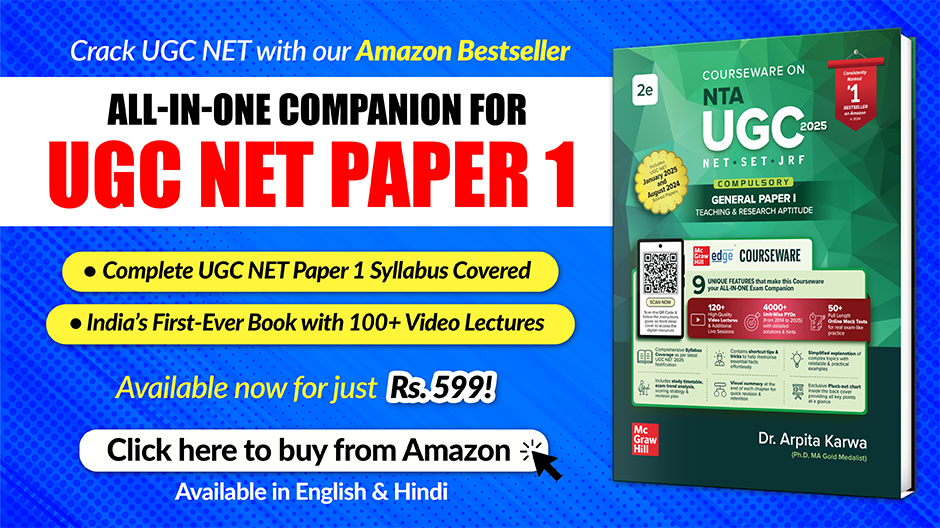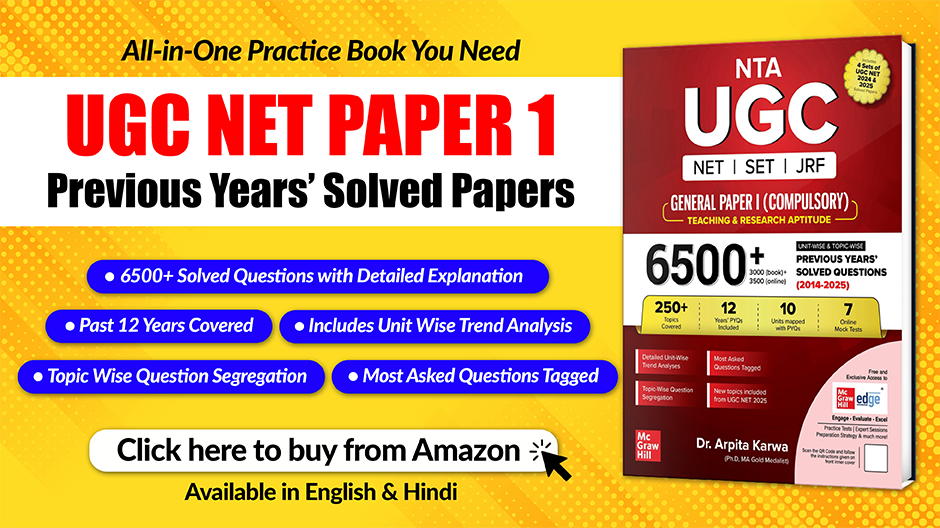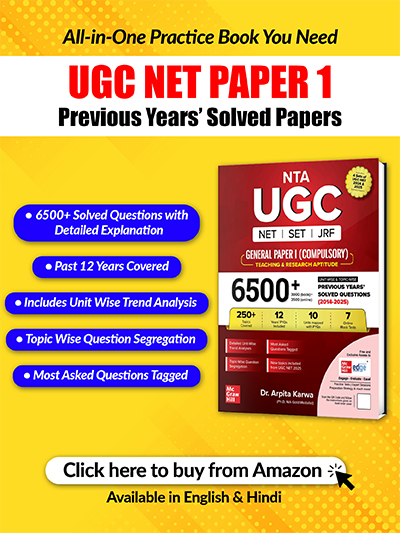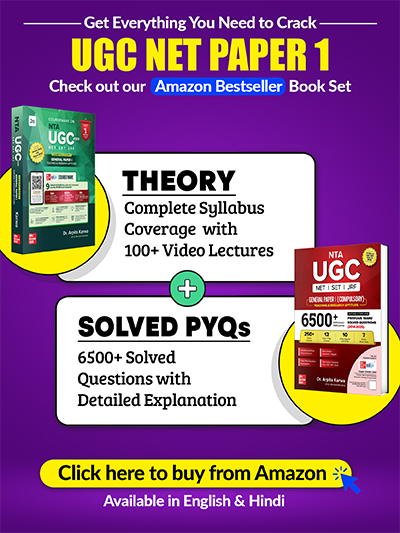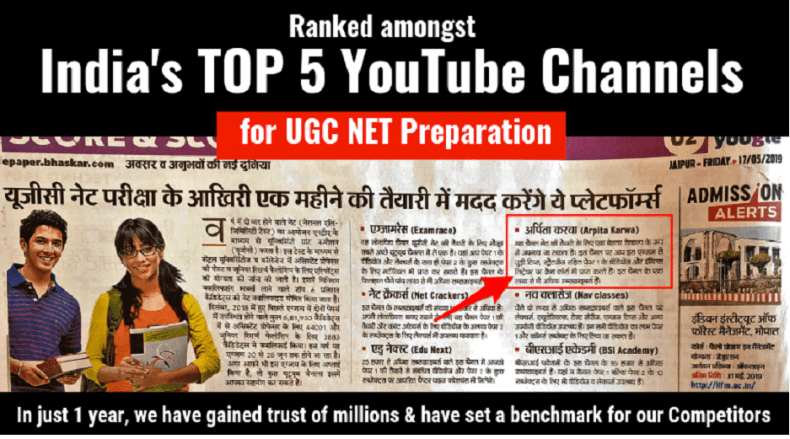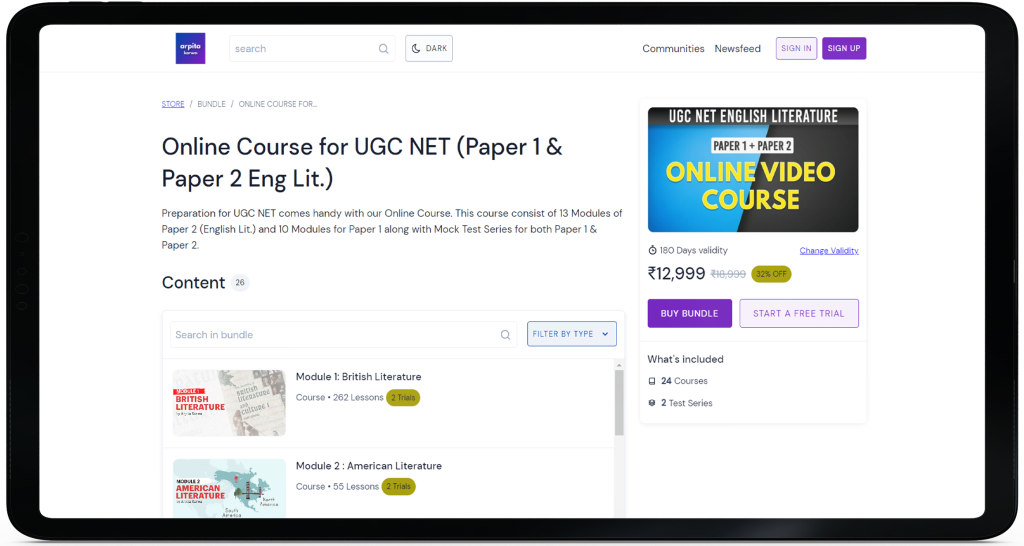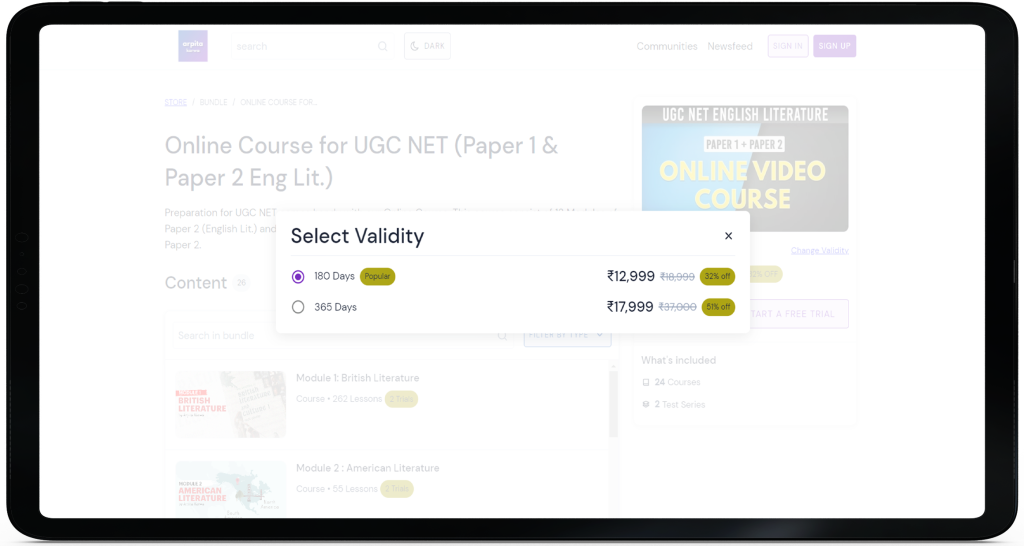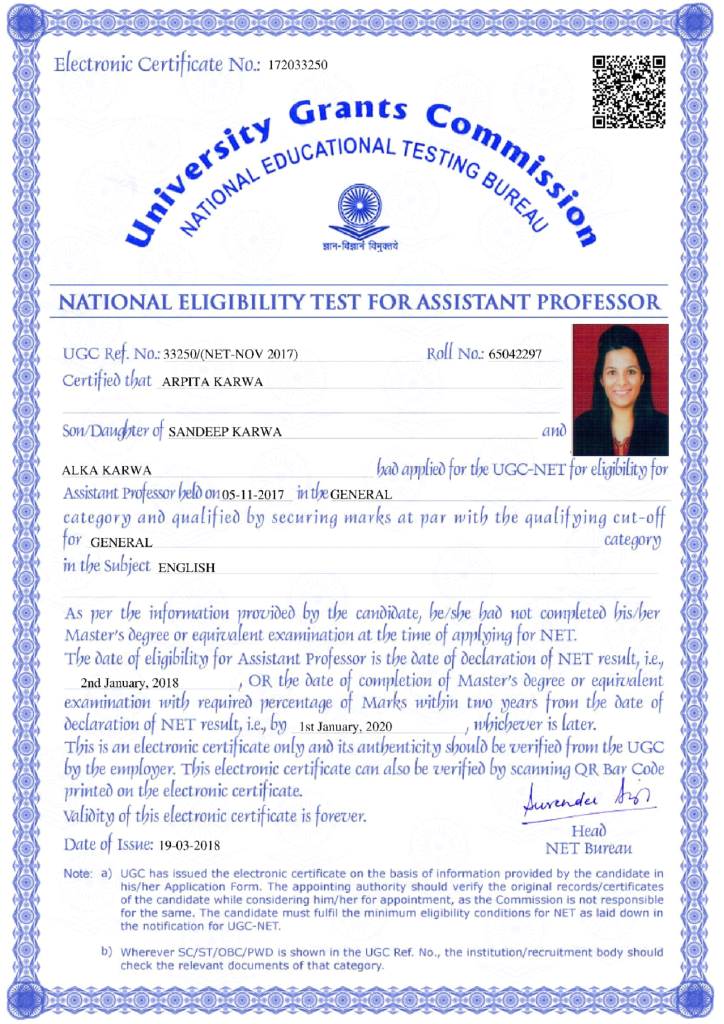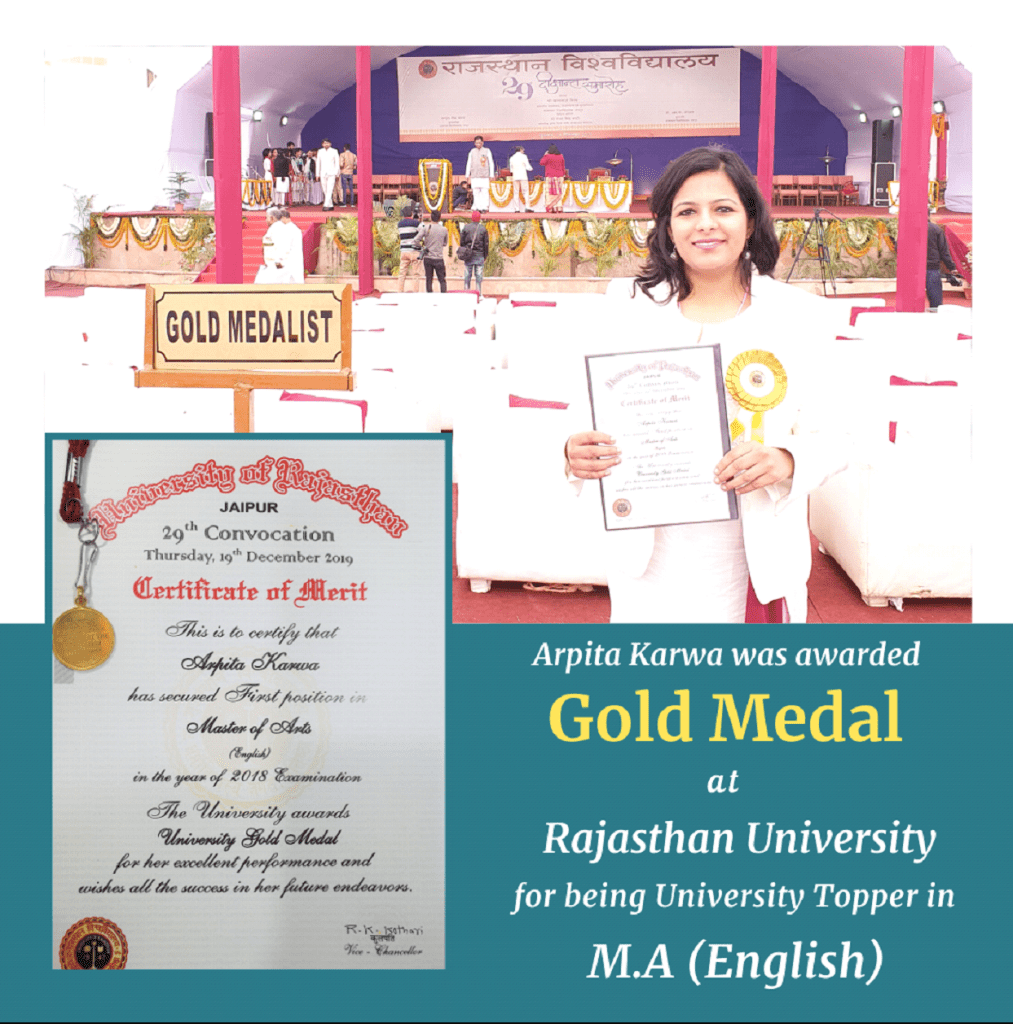UGC NET Paper 1 December 2021 (Conducted on 1st December 2021 : Morning Shift)
October 18, 2022 2025-08-18 16:19UGC NET Paper 1 December 2021 (Conducted on 1st December 2021 : Morning Shift)
December 2021: Paper 1 (Conducted on 1st Dec 2021 : Morning Shift)
Q.1-5)
Q.1) Find out the total number of male students in the college.
[1] 1120
[2] 1125
[3] 1130
[4] 1135
Correct Answer: 2
Q.2) Find out the difference between the total number of male students and total number of female students in the college.
[1] 380
[2] 390
[3] 400
[4] 410
Correct Answer: 3
Q.3) Find out the ratio of female students in graduation (BSc + BA) and female students in post graduation (MSc + MA)
[1] 435/ 217
[2] 438/ 219
[3] 437/ 223
[4] 439/ 223
Correct Answer: 4
Q.4) Find out the difference between male students in graduation (BSc + BA) and male students of post-graduation (MA + MSc).
[1] 213
[2] 214
[3] 215
[4] 216
Correct Answer: 2
Q.5) Q. As students mature, the study of social issues at the community, state, national and international levels can be made available to them. Which model is designed for this purpose?
[1] Role playing
[2] Jurisprudential inquiry
[3] Structured inquiry
[4] Group investigation
Correct Answer: 2
Q.6) Arrange the phases for syntax of Group Investigations Model in correct sequence:
A. Students formulate study task and organise for study
B. Students analyse progress and process
C. Students encounter puzzling situation
D. Independent and Group study
E. Students explore reactions to the situation
[1] A,C,B,E,D
[2] B,A,D,E,C
[3] C,E,A,D,B
[4] D,E,B,A,C
Correct Answer: 3
Q.7) Statement I: The core of the teaching process is the arrangement of environments within which students can interact and study how to learn.
Statement II: A model of teaching is not a description of a learning environment.
[1] Both Statement I and Statement Il are correct
[2] Both Statement I and Statement Il are incorrect
[3] Statement I is correct but Statement Il is incorrect
[4] Statement I is incorrect but Statement Il is correct
Correct Answer: 3
Q.8) The 4Rs approach to conflict resolution comprises:
A. Reading
B. Writing
C. Respect
D. Reprimand
E. Resolution
[1] A, B, C and D only
[2] A, B, C and E only
[3] B, C, D and E only
[4] A, B, D and E only
Correct Answer: 2
Q.9) Match the column:
Piaget’s stages of cognitive development
A. Sensorimotor
B. Preoperational
C. Concrete operational
D. Formal operational
Approximate age
I. begins about the first grade to early adolescence, around 11 years old.
II. adolescent to adulthood
III. 0-2 years
IV. begins about the time the child starts talking to about 7 years old
[1] A-IV B-I C-II D-III
[2] A-II B-III C-IV D-I
[3] A-I B-II C-III D-IV
[4] A-III B-IV C-I D-II
Correct Answer: 4
Q.10) Discourse analysis in historical research is associated with
[1] Hobsbawn
[2] Carr
[3] Skinner
[4] Foucault
Correct Answer: 4
Q.11) Which of the following are examples of violation of research ethics?
A. Violating participant confidentiality
B. Making recommendations beyond the scope of data collected
C. Using an inappropriate research design
D. Changing data to meet a desired outcome
E. Using a quantitative method in place of a qualitative method
[1] A, B, C and D only
[2] B, C, D and E only
[3] A, B and D only
[4] B, D and E only
Correct Answer: 3
Q.12) Statement I: Experimenter effects are errors introduced during the collection or analysis of experimental data due to the behaviour of the experimenter.
Statement II: Due to the presence of certain cues in the experimental setting, the participants form an interpretation of the experiment’s purpose and subconsciously change their behaviour to fit that interpretation.
[1] Both Statement I and Statement Il are correct
[2] Both Statement I and Statement Il are incorrect
[3] Statement I is correct but Statement Il is incorrect
[4] Statement I is incorrect but Statement Il is correct
Correct Answer: 1
Q.13) Assertion A: The major deficiency of pre-experimental design is that they fail to provide comparison groups.
Reason R: Equivalence can be achieved through matching and random assignment.
[1] Both A and R are true and R is the correct explanation of A
[2] Both A and R are true but R is NOT the correct explanation of A
[3] A is true but R is false
[4] A is false but R is true
Correct Answer: 2
Q.14) Assertion A: In the case study method, the researcher collects detailed information from a limited number of participants.
Reason R : Findings based on case study research can be used to develop research hypotheses/questions for subsequent studies.
[1] Both A and R are true and R is the correct explanation of A
[2] Both A and R are true but R is NOT the correct explanation of A
[3] A is true but R is false
[4] A is false but R is true
Correct Answer: 2
Q.15) The Gandhian method of communication is known as:
[1] Non-technological
[2] Massive
[3] Personal
[4] Mass Line
Correct Answer: 4
Q.16) Modern mass communication has the characteristics of being-
A. Sporadic
B. Continuous
C. Based on a schedule
D. Not much dependent on technology
E. Dependent on the use of media
[1] A, B, C
[2] B, C, E
[3] C, D, E
[4] A, D, E
Correct Answer: 2
Q.17) Statement I: The primary act of communication begins when an individual decides to use a particular language symbol, susceptible to standardised interpretation, resulting in common meaning.
Statement II: Meaning refers to inner, subjective reactions to images, interpretations, emotions and feelings as given out by the words used.
[1] Both Statement I and Statement Il are true
[2] Both Statement I and Statement II are false
[3] Statement I is true but Statement I is false
[4] Statement I is false but Statement Il is true
Correct Answer: 1
Q.18) Find out the sequence of elements of effective communication as listed by Cutlip et al
A. Promise of reward
B. Message clarity
C. Consistency
D. Climate of belief
E. Participatory context
[1] A,B,D,E,C
[2] C,D,E,A,B
[3] D,E,A,B,C
[4] E,A,C,D,B
Correct Answer: 3
Q.19) Match the column:
A. Gatekeeping
B. Persuasion
C. Entropy
D. Memory
I. Time-binding capacity
II. News
III. Advertising
IV. Chaos in communication
[1] A-II B-III C-IV D-I
[2] A-III B-IV C-I D-II
[3] A-IV B-I C-II D-III
[4] A-I B-II C-III D-IV
Correct Answer: 1
Q.20) The angle between hour hand and the minute hand at 3:40 pm is
[1] 130°
[2] 150°
[3] 120°
[4] 125°
Correct Answer: 1
Q.21) A sum of money on simple interest doubles itself in 10 years . It will triple itself in
[1] 15
[2] 20
[3] 30
[4] 32
Correct Answer: 2
Q.22) Find the missing term in the following series
2,9, 37, 149, ?
[1] 594
[2] 298
[3] 299
[4] 597
Correct Answer: 4
Q.23) Average of ten positive numbers is X. If each number is increased by 10 %, then new average increases by:
[1] 12%
[2] 11%
[3] 10%
[4] 8%
Correct Answer: 3
Q.24) Statement I: The average of first twenty multiples of 9 is 92.5.
Statement Il: The average of first ten multiples of 11 is 60.5.
[1] Both Statement | and Statement Il are true
[2] Both Statement | and Statement II are false
[3] Statement | is true but Statement I is false
[4] Statement I is false but Statement Il is true
Correct Answer: 4
Q.25) Which of the following statements is/ are true ?
A. The terms ‘true’ and ‘false’ apply to arguments.
B. The terms ‘true’ and ‘false’ apply to statements.
C. The terms ‘valid’ and “invalid apply to arguments.
D. The terms ‘cogent’ and ‘non-cogent’ apply to statements.
[1] A and C only
[2] B and C only
[3] C and D only
[4] A and D only
Correct Answer: 2
Q.26) Statement I: Two contrary statements cannot both be false.
Statement II: Two contrary statements cannot both be true.
[1] Both Statement I and Statement Il are true
[2] Both Statement I and Statement Il are false
[3] Statement I is true but Statement Il is false
[4] Statement I is false but Statement Il is true
Correct Answer: 4
Q.27) Identify the fallacy committed in the argument-
No tragic actors are happy men.
Some comedians are not happy men.
Therefore, some comedians are not tragic actors.
[1] Fallacy of Undistributed Middle
[2] Fallacy of Illicit Major
[3] Fallacy of Exclusive Premises
[4] Existential fallacy
Correct Answer: 3
Q.28) Identify the correct sequence of Inference from beginning to end, according to the Nyaya system.
A. Udaharana
B. Hetu
C. Pratijna
D. Nigamana
E. Upanaya
[1] C, A, B, E, D
[2] B, A, D, C, E
[3] B, A, C, D, E
[4] C, B, A, E, D
Correct Answer: 4
Q.29) Statement I: In the Nyaya system, inference is made from the particular to the particular through the Universal.
Statement II: In the Nyaya system, inference is made from the Universal to the Universal through the particular.
[1] Both Statement I and Statement Il are correct
[2] Both Statement I and Statement Il are incorrect
[3] Statement I is correct but Statement Il is incorrect
[4] Statement I is incorrect but Statement Il is correct
Correct Answer: 3
Q.30) A device driver is
[1] A port that connects a device and a system
[2] A software that performs disk compression
[3] A software that performs disk defragmentation
[4] A software that communicates with the operating system and translates data into a format understood by the device
Correct Answer: 4
Q.31) What is Anti-spyware software?
[1] Checks files before they are loaded on a computer
[2] Manages the data traffic
[3] It detects and removes programs installed illegally on a user’s computer system
[4] Makes the files non-readable
Correct Answer: 3
Q.32) Statement I: Address bus carries signals relating to addresses between the processor and memory
Statement II: It is bi-directional
[1] Both Statement I and Statement Il are true
[2] Both Statement I and Statement II are false
[3] Statement I is true but Statement I is false
[4] Statement I is false but Statement Il is true
Correct Answer: 3
Q.33) Which of the following statements about Anti-virus software are correct?
A. Problem files/programs are quarantined and can be automatically removed
B. Check all files before being loaded or run
C. Use a database to identify potential risks
D. Used for data authenticity
[1] B, C and D only
[2] A, B and C only
[3] A, C and D only
[4] A, B and D only
Correct Answer: 2
Q.34) Match the column:
A. Measurement applications
B. Control application
C. Modelling applications
D. Expert systems
I. Simulating car crashes
II. River pollution
III. Automatic oven
IV. Medical diagnosis
[1] A-IV B-I C-II D-III
[2] A-I B-II C-IV D-III
[3] A-II B-III C-IV D-I
[4] A-II B-III C-I D-IV
Correct Answer: 4
Q.35) Convention on Biodiversity was signed during
[1] Montreal Protocol, 1987
[2] Earth Summit at Rio de Janeiro, 1992
[3] Kyoto Protocol, 1997
[4] Human Environment Conference, Stockholm, 1972
Correct Answer: 2
Q.36) Statement I: Aerobic digestion of sewage sludge requires lots of energy
Statement II: Aerobic digestion of sewage sludge produces huge amount of methane
[1] Both Statement I and Statement Il are true
[2] Both Statement I and Statement II are false
[3] Statement I is true but Statement I is false
[4] Statement I is false but Statement Il is true
Correct Answer: 3
Q.37) Assertion A : Ground level concentration of ozone decreases at night
Reason R : Ultraviolet radiation photolyses the ozone into other components
[1] Both A and R are correct and R is the correct explanation of A
[2] Both A and R are correct but R is NOT the correct explanation of A
[3] A is correct but R is not correct
[4] A is not correct but R is correct
Correct Answer: 2
Q.38) Targets of Goal 7 of the Millennium Development Goals (MDG) are
A. Control global warming
B. Universal access to modern energy
C. Increase global percentage of renewable energy
D. Mitigating air pollution
E. Double the improvement in energy efficiency
[1] A, B, C and D only
[2] B, C and D only
[3] B, C and E only
[4] A, C, D and E only
Correct Answer: 3
Q.39) Solar water still is a device to
[1] Pump water using solar energy
[2] Convert saline water to potable water using solar energy
[3] Heat water using solar energy
[4] Generate electricity using solar energy
Correct Answer: 2
Q.40) As per NEP-2020, the responsibility to develop Adult Educator Framework has been given to which one of the following organisations?
[1] MHRD
[2] NCTE
[3] NIEPA
[4] NCERT
Correct Answer: 4
Q.41) Which one of the following led to the formulation of 10+2+3 system of education?
[1] Macaulay’s Minute
[2] Hunter Commission
[3] Elphinstone report
[4] Wood’s despatch
Correct Answer: 4
Q.42) ERIC is a unit in which one of the following organisations?
[1] NCTE
[2] NCERT
[3] NIEPA
[4] NRF
Correct Answer: 2
Q.43) Assertion A: To make it easier for government as well as non-government philanthropic organisations to build schools regulations on inputs should be limited to certain areas only.
Reason R: Government should provide effective, enabling and sufficient infrastructure so that all schools have access to safe and engaging school education.
[1] Both A and R are correct and R is the correct explanation of A
[2] Both A and R are correct but R is NOT the correct explanation of A
[3] A is correct but R is not correct
[4] A is not correct but R is correct
Correct Answer: 1
Q.44) Statement I: It is obvious that if higher education is not radically improved, our administration and technical progress, our intellectual standards and social advance will be most seriously handicapped. This is a major recommendation of the University Education Commission
Statement II: The University Grants Commission was established in accordance with the recommendation of the National Education Commission
[1] Both Statement I and Statement Il are true
[2] Both Statement I and Statement II are false
[3] Statement I is true but Statement II is false
[4] Statement I is false but Statement Il is true
Correct Answer: 2
Q.45-50)
Read RC Passage to Answer:
There is a question whether advertising induces demand for an individual company’s product more or less elastic. The evidence indicates that the advertising of brands tends to make their demands relatively inelastic for varying periods of time. The data which support this condition are found in the relatively rigid prices of many advertised articles. That brand advertising would have this effect is natural, for an objective of brand advertising is to build consumer preferences. Some consumers will stick by a brand even though its price relationship with competing brands are disturbed. Clearly, the establishment of strong brand preference has led some manufacturers to act as though these preferences made the demand for their brands relatively inelastic. Rarely have they tested the inelasticity of their brands by raising and holding up their prices when competitors have failed to follow similar procedures. Yet, numerous examples were found in which manufacturers in periods of depression held their prices rigid while prices generally and the prices of some competitors were being lowered. In all such instances price competition was found to come into play sooner or later, and either demand shifted to sellers with lower prices or a reduction in price was forced. The quickness with which price competition comes into play varies in different product fields. In the fields of proprietary remedies, the highly individualised nature of the branded products and the tendency of consumers to build strong attachments to brands has given these brands an inelastic demand over relatively long periods of time. Even in these instances, however, price competition has eventually developed.
Q.45) The demand inelasticity of articles in terms of non-varying prices is due to
[1] Consumer ignorance
[2] Varying time factor
[3] Differences in products
[4] Advertising of branded products
Correct Answer: 4
Q.46) Why do some manufacturers make their brands of products demand inelastic ?
[1] Holding price line
[2] Market trend
[3] Strong consumer preference
[4] Competitors increasing the price line
Correct Answer: 3
Q.47) What was the post-depression development as regards product pricing ?
[1] Stabilisation of prices
[2] Price competition, resulting in reduction
[3] Shift in demand to consumers
[4] Increased market for branded products
Correct Answer: 2
Q.48) Strong consumer attachment for branded products eventually led to
[1] Lasting demand inelasticity
[2] Uniform pricing
[3] Cartelisation of manufacturers
[4] Branded products falling in line
Correct Answer: 4
Q.49) The passage focuses upon
[1] Price competition and branded products
[2] Impact of advertising on product pricing
[3] Proprietary remedies for branded articles
[4] Promotion of branded products in the sellers’ market
Correct Answer: 1
Address
Bani Park, Jaipur, Rajasthan 302016
contact@arpitakarwa.com
Contact
Connect with us




Courses
Quick Links
Don’t waste time browsing several apps. The only app you need for your Exam Preparation is here!


